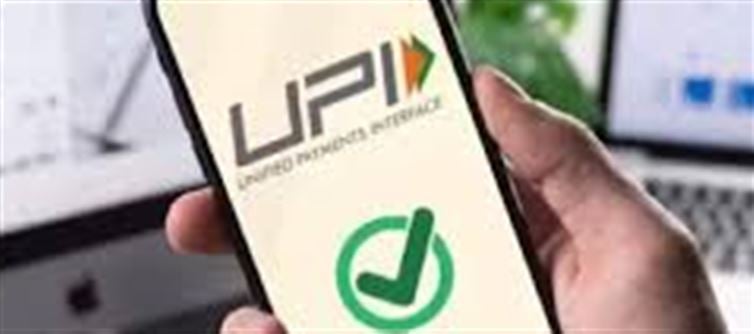
In a significant move towards enhancing wallet PLATFORM' target='_blank' title='digital-Latest Updates, Photos, Videos are a click away, CLICK NOW'>digital payment security and convenience, the Unified Payments Interface (UPI) is rolling out a new feature: biometric authentication. This means users will no longer need to enter their PIN to approve UPI transactions. Instead, face recognition or fingerprint scanning will take center stage for seamless payments. Here's everything you need to know about this game-changing update.
1. Goodbye PIN, hello Biometrics
The most exciting change is that UPI transactions will now be authorized using biometric data, such as your face or fingerprint. Gone are the days of having to type in your PIN every time you make a payment. With just a simple scan, your payment will be approved in seconds.
Tip: biometric authentication is not only faster but also safer, as it reduces the chances of someone gaining unauthorized access to your account through PIN theft.
2. A Leap in Security: Why biometric Authentication?
The integration of biometrics ensures a higher level of security in wallet PLATFORM' target='_blank' title='digital-Latest Updates, Photos, Videos are a click away, CLICK NOW'>digital payments. Fingerprint or facial recognition adds an additional layer of protection over traditional PIN entry, which can be easily compromised.
Tip: This will significantly decrease fraud risks, as biometrics are unique to each individual, making it difficult for anyone other than the account holder to authorize a payment.
3. How Does It Work? Simple & Secure
To enable biometric authentication, users need to register their fingerprint or face data in their UPI app settings. Once this is done, each payment will be authorized by scanning your fingerprint or using facial recognition, depending on the device’s capabilities.
Tip: Make sure your device has a functioning fingerprint scanner or front-facing camera for the smoothest experience.
4. Faster Payments: No More PIN Fatigue
UPI is already known for its speed, but now, transactions will be even quicker. With biometric approval, the entire process of making a payment—from scanning the code to confirming the transaction—can happen in just a few seconds.
Tip: This is ideal for small-value transactions, such as shopping, bill payments, and even splitting lunch bills with friends.
5. Accessible for All: A Boon for the Elderly and Differently Abled
Biometric authentication is especially beneficial for senior citizens or people with disabilities who may struggle with remembering or entering PINs. Face and fingerprint recognition provides a more accessible method of securing payments.
Tip: This development makes UPI more inclusive, ensuring that everyone can enjoy seamless wallet PLATFORM' target='_blank' title='digital-Latest Updates, Photos, Videos are a click away, CLICK NOW'>digital payments, regardless of physical limitations.
6. Cross-Platform Compatibility
The new biometric payment feature isn’t just restricted to smartphones. Many UPI apps will soon integrate biometric authentication for use on tablets, laptops, and wearables like smartwatches, making payments even more convenient.
Tip: Make sure your UPI app is updated to the latest version to access this new feature across devices.
7. Privacy Protection: Your Data, Your Control
Concerns around data privacy are always top of mind when it comes to biometric systems. Rest assured, your biometric data will be encrypted and stored securely on your device, not on UPI servers. Only your device has access to your fingerprint or face data.
Tip: Keep your device updated with the latest security patches to ensure your biometric data is always safe.
8. UPI’s Push for Financial Inclusion
This biometric authentication system aligns with UPI’s goal to drive financial inclusion in India. By simplifying the payment process, UPI can reach more people, including those in rural areas who may not be familiar with PIN-based systems.
Tip: UPI apps will likely become more user-friendly, with tutorials and support to assist first-time users, especially in remote regions.
9. Securely Link Your biometric Authentication to Your bank Account
To make use of this biometric feature, you’ll need to link your biometric details to your bank account through your UPI app. This process will be straightforward and secured by multi-factor authentication to prevent fraud.
Tip: Always ensure that your phone is password-protected and your UPI app is secured with additional layers of security, such as two-factor authentication, for enhanced safety.
10. What Happens If Your Biometrics Aren’t Recognized?
If your fingerprint or face scan fails to authenticate for any reason, you’ll still have the option to enter your PIN as a backup. This ensures that you’re never locked out of your account, no matter what.
Tip: In case of recurring biometric issues, make sure to re-register your fingerprint or facial data in your UPI app settings.
Final Thoughts:
The introduction of biometric authentication in UPI payments is a huge step towards more secure, efficient, and user-friendly wallet PLATFORM' target='_blank' title='digital-Latest Updates, Photos, Videos are a click away, CLICK NOW'>digital transactions. As biometrics become the new standard for payment verification, UPI is setting a new benchmark for convenience and security in the financial sector. Ready to make payments with just a touch or a glance? It’s time to leave PINs behind and embrace the future of payments!
Disclaimer:
The views and opinions expressed in this article are those of the author and do not necessarily reflect the official policy or position of any agency, organization, employer, or company. All information provided is for general informational purposes only. While every effort has been made to ensure accuracy, we make no representations or warranties of any kind, express or implied, about the completeness, reliability, or suitability of the information contained herein. Readers are advised to verify facts and seek professional advice where necessary. Any reliance placed on such information is strictly at the reader’s own risk.
.jpg)




 click and follow Indiaherald WhatsApp channel
click and follow Indiaherald WhatsApp channel